Corsair Obsidian 900D Case Review: Think Big, That's Only HALF as Large
by Dustin Sklavos on April 16, 2013 11:00 AM EST- Posted in
- Cases/Cooling/PSUs
- Corsair
- Water Cooling
- ATX
- XL-ATX
Noise and Thermal Testing
As I mentioned in the introduction, doing our standard noise and thermal testing on the Corsair Obsidian 900D is primarily an academic affair. When you're dealing with a liquid cooling system, optimal airflow design becomes slightly less important. This isn't an air cooling case the way, say, a SilverStone FT02 might be.
Ambient temperature was 21C during testing.


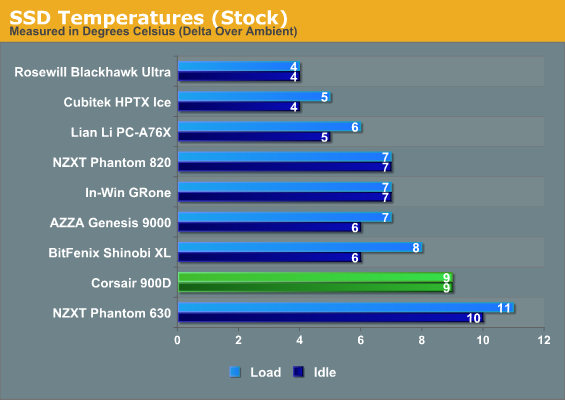
In its stock configuration, the 900D is closer to the middle of the road. This isn't a tremendous surprise; the stock fans are about as basic as a $349 case is going to get.
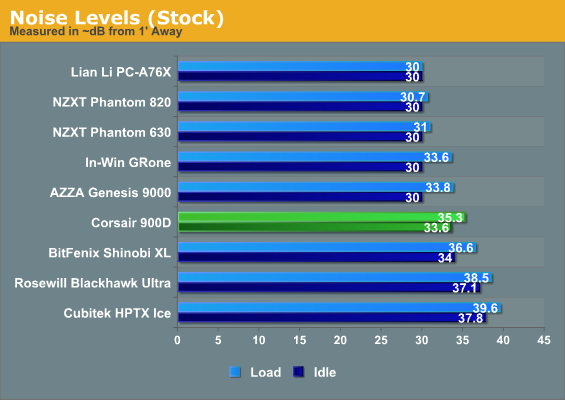
Because the 900D doesn't include a fan controller, the fans included push the case's bare minimum noise level to 33.6dB.
Overclocking the system should produce fairly similar results.
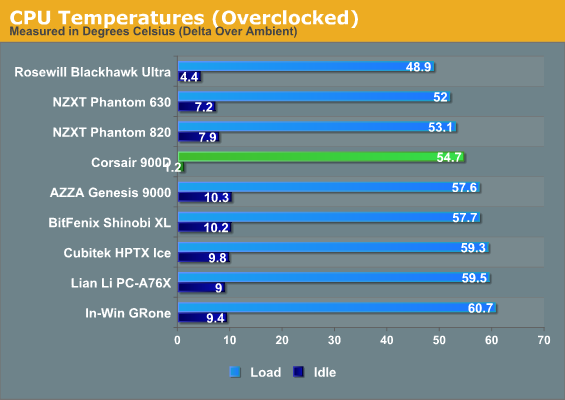
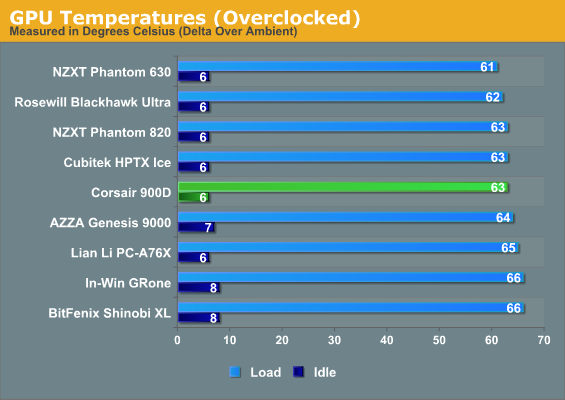
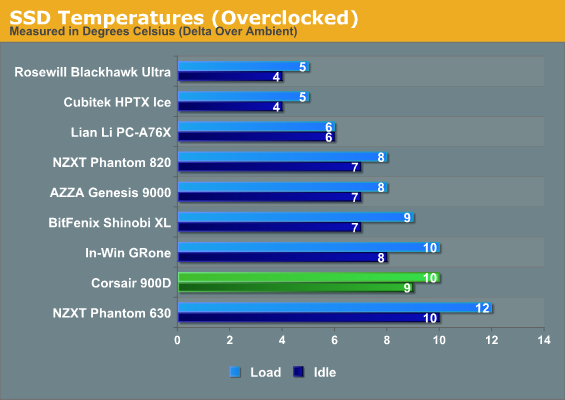
Again, the 900D produces...acceptable results as an air cooling case.
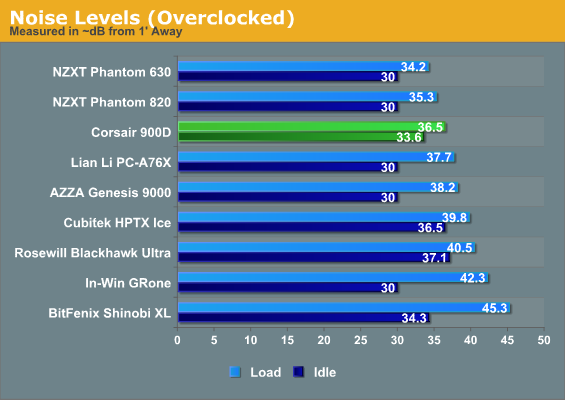
Noise continues to be an issue due both to the lack of a fan controller and the lack of any acoustic padding in the enclosure itself. While we're not judging the 900D on the terms it's meant to be judged by here, I do think omitting noise dampening material may have been a poor decision on Corsair's part.
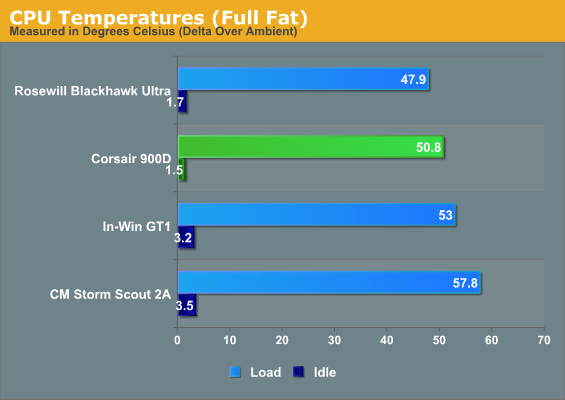
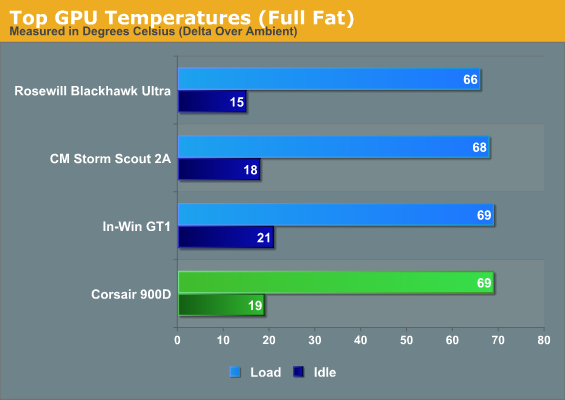

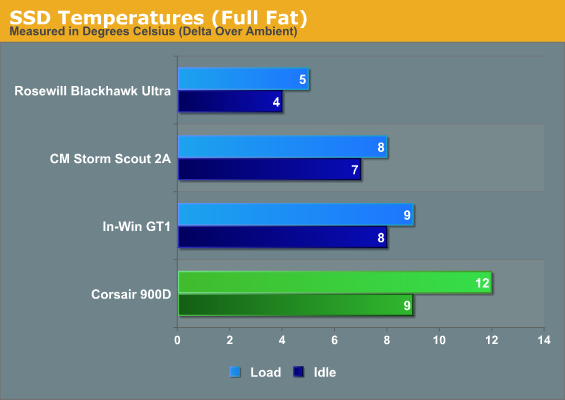
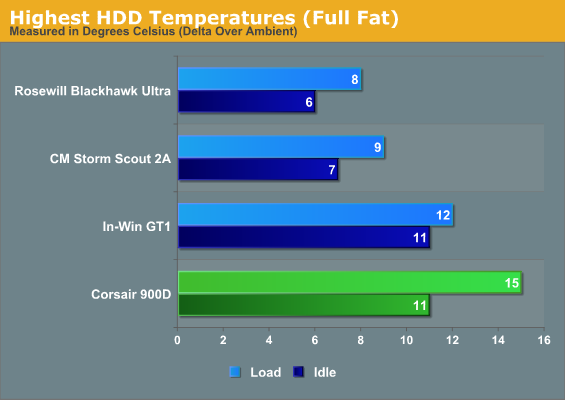
Up until this point drive thermals have been fairly poor, but please note that even under the worst circumstances we're still talking about being 10-15C below spec for these drives at least. They're still running cool, it's just not the aggressive over-cooling a lot of enthusiast cases do.
That said, stock air cooling continues to be fairly underwhelming. This is one place where the competing Rosewill Blackhawk Ultra does have an edge: it includes a stock air cooling design that's pretty aggressive and effective.
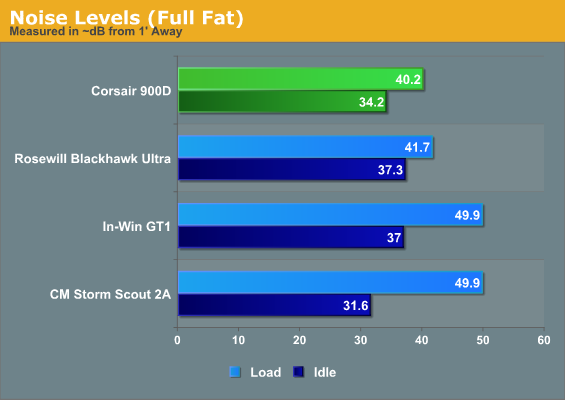
Despite the lack of a fan controller, under our most stressful test the 900D is able to run quieter than any of the other cases we've reviewed since adding the "full fat" testbed.










65 Comments
View All Comments
Subyman - Tuesday, April 16, 2013 - link
I have a 800D and would not purchase something like this again. I really like the case, very well built, and so forth but with boutique manufacturers like Case Labs making thick, aluminum cases that weigh half as much with ridiculous customization, it seems a serious watercooling enthusiast has better choices out there. The 900D looks great and well built, but steel at $349 + 41lbs dry is rough. Believe me, a fully loaded 800D was is ***** to move! No wheel option is a little disappointing as well with something this large.hero1 - Tuesday, April 16, 2013 - link
This. I had absolutely forgotten about Case Labs as of late. And you do have a good point here and I think most people ought to know that they can have better cases for similar price or slightly more.Blindsay04 - Wednesday, April 17, 2013 - link
Case labs makes some quality stuff but their pricing is a lot more. SMH10 is $500 and that is probably the closest to the 900Dpensive69 - Wednesday, May 15, 2013 - link
see? Subyman picked up on the need for wheels...and the case didn't seem to have what i might term
non slip handholds either.
that's where my insurance kicks in.
good god
DanNeely - Tuesday, April 16, 2013 - link
it would require changing the appearance slightly; but to make installing cards easier I'd suggest putting holes in the frame at the proper screw location and extending the side panel to cover them. It worked well in one of the more plebeian cases I've used.I've had trouble with hinged toolless latching mechanisms not being compatible with dual slot GPUs before and am leery about suggesting them for something like this; although with a watercooled card the obstruction might not be an issue.
minijedimaster - Tuesday, April 16, 2013 - link
So they basically just took a Fractal Design XL R2 and modified it, slapped their name on it and called it a day.http://www.fractal-design.com/?view=product&ca...
santiagoanders - Tuesday, April 16, 2013 - link
The interior is much more similar to the CoolerMaster Cosmos IIJFord047 - Wednesday, April 17, 2013 - link
Which is basically Just an Antec Performance case re-jiggedSabresiberian - Tuesday, April 16, 2013 - link
Not sure why someone would question the "need" for this over the 800D. It's pretty simple:800D - 7 Expansion slots
900D - 10 Expansion slots
The 900D will simply hold a much larger mainboard. The 800D might well be crowding a third graphics card, and a fourth one would be out of the question.
Aikouka - Tuesday, April 16, 2013 - link
I already own an 800D, and it's nice to see that they addressed the cable routing shortcomings in that case. It annoys me that I spent $300 on that case to see the side panel bow out because I'm routing a fairly common number of cables behind the case. While the side panel bowing doesn't really hamper you, I have found another issue with it that makes me reconsider ever buying another Corsair case. The other issue is that the 800D is limited in regard to the radiator sizes that it supports. Why is it that Corsair designed the 800D, their previous flagship case, to only support up to a 240mm radiator? If I had to guess, it's probably because Corsair was only selling a 240mm solution at this point (their H100 all-in-one). However, a few months ago, Corsair released a 280mm all-in-one solution called the H110i, which isn't even supported by the 800D!